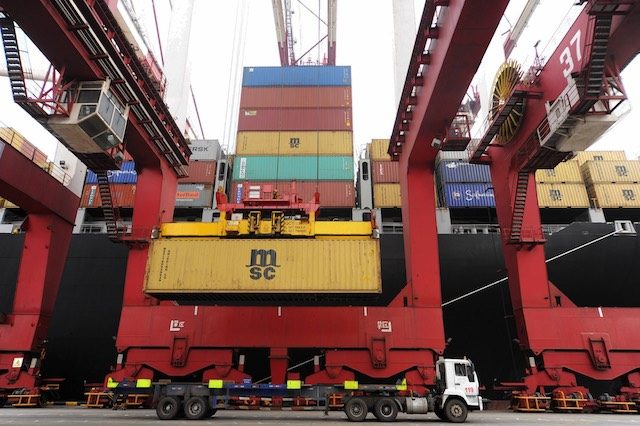SUMMARY
This is AI generated summarization, which may have errors. For context, always refer to the full article.

BEIJING, China (UPDATED) – Chinese exports surged in March, the first gain in 9 months and the latest positive data out of the world’s number two economy, but analysts warned the headline figure on Wednesday, April 13, masked ongoing weakness in overseas demand.
Official figures showing a better-than-expected jump in shipments abroad come just days after another strong inflation reading and last week’s surprise jump in an index of factory activity.
The results fueled hopes that a growth slowdown in the world’s biggest trader in goods and crucial pillar of global trade may be bottoming out. Investors welcomed the news, sending the benchmark Shanghai composite index up 1.42% and Hong Kong’s Hang Seng index up 3.19%.
The figures came ahead of the release Friday, April 15, of first-quarter gross domestic product data, which a poll by AFP forecast would show expansion weakened further.
Customs said exports increased 11.5% on-year to $160.8 billion, beating the 10% rise economists predicted in a Bloomberg survey and snapping an 8-month streak of declines caused by waning global demand. Exports plunged more than 25% in February.
But imports fell for the 17th consecutive month, albeit at a slower pace, dropping 7.6% on-year to $131.0 billion, Customs said.
However, analysts pointed out that the latest figures were helped by having a low basis of comparison, after exports plunged 15.0% year-on-year in March 2015.
Zhao Yang of Nomura said in a note that shipments rose mainly because of the “low base and calendar effect” due to seasonal distortions around the Lunar New Year holiday, and warned that “external demand has not improved as much as the number may suggest.”
But the pace of import declines reduced, he noted, “possibly driven by faster investment and government spending.”
A recent pickup in electronic supply chains as new mobile phones were launched in March may have contributed to export strength, ANZ Research said in a note, adding that import data indicate “stabilization” of commodity prices.
The March trade surplus leaped to $29.9 billion, nearly 10 times the dollar figure for the same month last year.
After decades of double-digit expansion, China’s economy grew 6.9% in 2015, the weakest in a quarter of a century, as its leaders try to transition it from one driven by government investment and exports to domestic consumer demand.
The AFP survey saw a median estimate of 6.7% for January-March.
On Tuesday the International Monetary Fund raised its forecast for China growth 0.2 percentage points to 6.5% in its April 2016 World Economic Outlook report.
‘Obvious obstacles’
Customs said in a statement that while figures for the first quarter showed a yearly decline, seasonally adjusted monthly data were recovering.
“The import volume of major bulk commodities such as iron ore, crude oil, and copper maintained growth, while the prices of major import commodities remained low,” it said.
During the first 3 months of the year, China’s trade with the European Union, US and ASEAN all declined.
“There remain obvious obstacles facing China’s foreign trade development,” Customs said.
It initially gave the figures in yuan terms, which showed an 18.7% rise in exports and imports slipping 1.7%.
Customs spokesman Huang Songping attributed March export growth to the low comparison base as well as government policy support.
He said that free-trade agreements, improvement in the ailing manufacturing sector, and a stable yuan exchange rate were additional positive factors.
But he added: “The world economy still faces many uncertainties.”
Risk factors for world trade included major economies’ monetary policies, possible competitive currency devaluations, geopolitical conflicts, and rising protectionism, he said.
“The trade situation remains severe and complicated and the downward pressures are still big,” he told reporters.
“But positive factors that will promote trade are accumulating,” he added, expecting Chinese trade to “stabilize and improve” this year.
Electricity consumption rose 5.6% on-year in March, China’s top economic planner said Wednesday, on higher demand from households and the service sector, in what could be another positive sign of activity.
The trade data “add to growing evidence that the extreme gloom of a few weeks ago” about China’s economy was “misplaced,” economists at Capital Economics said.
But Louis Kuijs of Oxford Economics said that despite investors’ excitement over the headline figures, the underlying trends were “disappointing”, and the seasonally adjusted monthly figures showed “weak sequential momentum,” suggesting that “the rest of 2016 is likely to disappoint.” – Fran Wang, AFP / Rappler.com
Add a comment
How does this make you feel?
There are no comments yet. Add your comment to start the conversation.